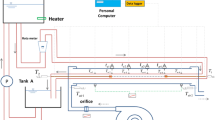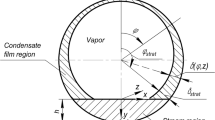Abstract.
A mathematical model based on the annular flow pattern is developed to simulate the evaporation of refrigerants flowing under varied heat flux in a double tube evaporator. The finite difference form of governing equations of this present model is derived from the conservation of mass, energy and momentum. The experimental set-up is designed and constructed to provide the experimental data for verifying the simulation results. The test section is a 2.5 m long counterflow double tube heat exchanger with a refrigerant flowing in the inner tube and heating water flowing in the annulus. The inner tube is made from smooth horizontal copper tubing of 9.53 mm outer diameter and 7.1 mm inner diameter. The agreement of the model with the experimental data is satisfactory. The present model can be used to investigate the axial distributions of the temperature, heat transfer coefficient and pressure drop of various refrigerants. Moreover, the evaporation rate or the other relevant parameters that is difficult to measure in the experiment are predicted and presented here. The results from the present mathematical model show that the saturation pressure and temperature of refrigerant decrease along the tube due to the tube wall friction and the flow acceleration of refrigerant. The liquid heat transfer coefficient increases with the axial length due to reducing the thickness of the liquid refrigerant film. Due to increase of the liquid heat transfer coefficient, increasing wall heat flux is obtained.Finally, the evaporation rate of refrigerant increases with increasing wall heat flux.














Similar content being viewed by others
References
Yadigaroglu H; Lahey RT (1976) On the various forms of conservation equations in two-phase flow. Int J Multiphase Flow 2: 477–494
Wang CC (1997) A numerical method for thermally non-equilibrium condensing flow in a double-pipe condenser. Appl Thermal Eng 17: 647–660
Lu DC; Lee CC (1994) An analytical model of condensation heat transfer of non-azeotropic refrigerant mixtures in a horizontal tube. ASHRAE Trans 100: 721–731
Chiou CB; Lu DC; Wang CC (1996) Analysis of evaporation of non-azeotropic refrigerants in a horizontal tube. Appl Thermal Eng 16: 817–827
Friedel L (1979) Improved friction pressure drop correlation for horizontal and vertical two-phase pipe flow. Proceedings of European Two-phase Flow Group Meeting, Ispra, Italy, paper E2
Haaland SE (1983) Simple and explicit formulas for the friction factor in turbulent pipe flow. J Fluid Eng March: 89–90
Prandtl L (1944) Fuehrer durch die Stroemungslehre, Vieweg und Sohn, Braunschweig, Germany
Zivi SM (1968) Estimation of steady state steam void-fraction by mean of the principle of minimum entropy production. J Heat Transfer 90: 267–276
Whalley PB; Hewitt GF (1978) The correlation of liquid entrainment fraction and entrainment rate in annular two-phase flow. Report AERE-R9187, UK AEA, Harwell, UK
Chaddock JB; Noerager JA (1966) Evaporation of refrigerant 12 in a horizontal tube with constant wall heat flux. ASHRAE Trans 72: 90–101
McMillen L; Larson RE (1950) Discussion on annular heat transfer coefficients for turbulent flow. AIChE 40: 147–153
McLinden MO; Klein SA; Lemmon EW (1998) REFPROP, Thermodynamic and transport properties of refrigerants and refrigerant mixtures. NIST Standard Reference Database-version 6.01
Acknowledgements.
The present study was financially supported by the Thailand Research Fund (TRF) and the National Energy Policy Office (NEPO) whose guidance and assistance are gratefully acknowledged.
Author information
Authors and Affiliations
Corresponding author
Rights and permissions
About this article
Cite this article
Sripattrapan, W., Wongchang, T. & Wongwises, S. Heat transfer and two-phase flow characteristics of refrigerants flowing under varied heat flux in a double-pipe evaporator. Heat and Mass Transfer 40, 653–664 (2004). https://doi.org/10.1007/s00231-003-0444-x
Received:
Published:
Issue Date:
DOI: https://doi.org/10.1007/s00231-003-0444-x




